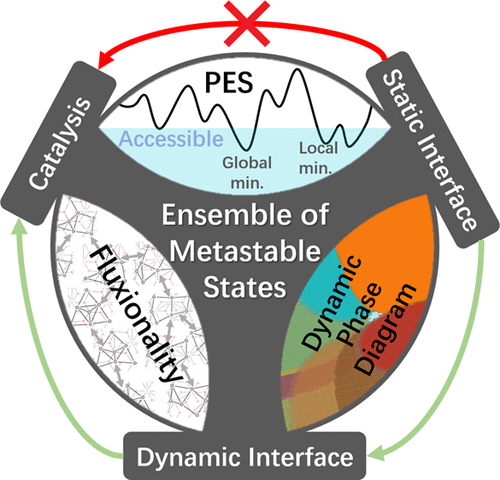当前位置:
X-MOL 学术
›
Acc. Chem. Res.
›
论文详情
Our official English website, www.x-mol.net, welcomes your
feedback! (Note: you will need to create a separate account there.)
Ensembles of Metastable States Govern Heterogeneous Catalysis on Dynamic Interfaces.
Accounts of Chemical Research ( IF 16.4 ) Pub Date : 2020-01-24 , DOI: 10.1021/acs.accounts.9b00531 Zisheng Zhang 1 , Borna Zandkarimi 1 , Anastassia N Alexandrova 1, 2
Accounts of Chemical Research ( IF 16.4 ) Pub Date : 2020-01-24 , DOI: 10.1021/acs.accounts.9b00531 Zisheng Zhang 1 , Borna Zandkarimi 1 , Anastassia N Alexandrova 1, 2
Affiliation

|
Heterogeneous catalysis is at the heart of the chemical industry. Being able to tune and design efficient catalysts for processes of interest is of the utmost importance, and for this, a molecular-level understanding of heterogeneous catalysts is the first step and indeed a prime focus of modern catalysis research. For a long time, the single most thermodynamically stable structure of the catalytic interface attained under the reaction conditions had been envisioned as the reactive phase. However, some catalytic interfaces continue to undergo structural dynamics in the steady state, triggered by high temperatures and pressures and binding and changing reagents. Among particularly dynamic interfaces are such widely used catalysts as crystalline and amorphous surfaced supporting (sub)nanometallic clusters. Recently, it became clear that this dynamic fluxionality causes the supported clusters to populate many distinct structural and stoichiometric states under catalytic conditions. Hence, the catalytic interface should be viewed as an evolving statistical ensemble of many structures (rather than one structure). Every member in the ensemble contributes to the properties of the catalyst differently, in proportion to its probability of being populated. This new notion flips the established paradigm and calls for a new theory, new modeling approaches, operando measurements, and updated design strategies. The statistical ensemble nature of surface-supported subnanocluster catalysts can be exemplified by oxide-supported and adsorbate-covered Pt, Pd, Cu, and CuPd clusters, which are catalytic toward oxidative and nonoxidative dehydrogenation. They have access to a variety of 3D and quasi-2D shapes. The compositions of their thermal ensembles are dependent on the cluster size, leading to size-specific catalytic activities and the famous "every atom counts" phenomenon. The support and adsorbates affect catalyst structures, and the state of the reacting species causes the ensemble to change in every reaction intermediate. The most stable member of the ensemble dominates the thermodynamic properties of the corresponding intermediate, whereas the kinetics can be determined by more active but less populated metastable catalyst states, and that suggests that many earlier studies might have overlooked the actual active sites. Both effects depend on the relative time scales of catalyst restructuring and reaction dynamics. The catalyst may routinely operate off-equilibrium. Ensemble phenomena lead to surprising exceptions from established rules of catalysis, such as scaling relations and Arrhenius behavior. Catalyst deactivation is also an ensemble property, and its extent of mitigation can be predicted through the new paradigm. These findings were enabled by advances in theory, such as global optimization and subsequent utilization of multiple local minima and pathways sampling as well as operando catalyst characterization. The fact that the per-site and per-species resolution is needed for the description and prediction of catalyst properties gives theory the central role in catalysis research, as most experiments provide ensemble-average information and cannot detect the crucial minority species that may be responsible for the catalytic activity.
中文翻译:

亚稳态态的集合控制动态界面上的异构催化。
非均相催化是化学工业的核心。能够针对感兴趣的过程调整和设计有效的催化剂至关重要,为此,对多相催化剂的分子水平的理解是第一步,也是现代催化研究的主要重点。长期以来,已经将在反应条件下获得的催化界面的最热力学上最稳定的结构设想为反应相。然而,由于高温和高压以及结合和变化的试剂的作用,一些催化界面在稳态下继续经历结构动力学。在特别动态的界面中,有广泛使用的催化剂,例如晶体和无定形表面的(亚)纳米金属簇。最近,显而易见的是,这种动态通量性导致负载的簇在催化条件下填充许多不同的结构和化学计量状态。因此,催化界面应被视为许多结构(而不是一种结构)的演化统计集合。集成中的每个成员对催化剂的性能的贡献均与其所填充的概率成比例。这个新概念颠覆了已建立的范例,并要求一种新的理论,新的建模方法,操作度量和更新的设计策略。表面负载的亚纳米簇催化剂的统计整体性质可以通过氧化物负载和吸附物覆盖的Pt,Pd,Cu和CuPd簇来例证,它们对氧化和非氧化脱氢具有催化作用。他们可以使用各种3D和准2D形状。它们的热合体的组成取决于簇的大小,导致特定大小的催化活性和著名的“每个原子数”现象。载体和吸附物影响催化剂的结构,并且反应物种的状态会导致集合体在每个反应中间体中发生变化。整体中最稳定的部分主导着相应中间体的热力学性质,而动力学可以由活性更高但人口较少的亚稳态催化剂状态决定,这表明许多早期研究可能忽略了实际的活性部位。两种效果都取决于催化剂重组和反应动力学的相对时间尺度。催化剂通常会失衡运行。集合现象导致已建立的催化规则出现令人惊讶的异常,例如比例关系和Arrhenius行为。催化剂失活也是一种整体性质,其缓解程度可以通过新的范式进行预测。这些发现是通过理论上的进步而实现的,例如全局优化以及随后对多个局部最小值的利用,途径采样以及操作催化剂表征。描述和预测催化剂性能需要按位和按物种的分辨率这一事实使理论在催化研究中发挥了核心作用,因为大多数实验提供了总体平均值信息,而无法检测出可能负责的关键少数物种的催化活性。
更新日期:2020-01-26
中文翻译:

亚稳态态的集合控制动态界面上的异构催化。
非均相催化是化学工业的核心。能够针对感兴趣的过程调整和设计有效的催化剂至关重要,为此,对多相催化剂的分子水平的理解是第一步,也是现代催化研究的主要重点。长期以来,已经将在反应条件下获得的催化界面的最热力学上最稳定的结构设想为反应相。然而,由于高温和高压以及结合和变化的试剂的作用,一些催化界面在稳态下继续经历结构动力学。在特别动态的界面中,有广泛使用的催化剂,例如晶体和无定形表面的(亚)纳米金属簇。最近,显而易见的是,这种动态通量性导致负载的簇在催化条件下填充许多不同的结构和化学计量状态。因此,催化界面应被视为许多结构(而不是一种结构)的演化统计集合。集成中的每个成员对催化剂的性能的贡献均与其所填充的概率成比例。这个新概念颠覆了已建立的范例,并要求一种新的理论,新的建模方法,操作度量和更新的设计策略。表面负载的亚纳米簇催化剂的统计整体性质可以通过氧化物负载和吸附物覆盖的Pt,Pd,Cu和CuPd簇来例证,它们对氧化和非氧化脱氢具有催化作用。他们可以使用各种3D和准2D形状。它们的热合体的组成取决于簇的大小,导致特定大小的催化活性和著名的“每个原子数”现象。载体和吸附物影响催化剂的结构,并且反应物种的状态会导致集合体在每个反应中间体中发生变化。整体中最稳定的部分主导着相应中间体的热力学性质,而动力学可以由活性更高但人口较少的亚稳态催化剂状态决定,这表明许多早期研究可能忽略了实际的活性部位。两种效果都取决于催化剂重组和反应动力学的相对时间尺度。催化剂通常会失衡运行。集合现象导致已建立的催化规则出现令人惊讶的异常,例如比例关系和Arrhenius行为。催化剂失活也是一种整体性质,其缓解程度可以通过新的范式进行预测。这些发现是通过理论上的进步而实现的,例如全局优化以及随后对多个局部最小值的利用,途径采样以及操作催化剂表征。描述和预测催化剂性能需要按位和按物种的分辨率这一事实使理论在催化研究中发挥了核心作用,因为大多数实验提供了总体平均值信息,而无法检测出可能负责的关键少数物种的催化活性。











































 京公网安备 11010802027423号
京公网安备 11010802027423号